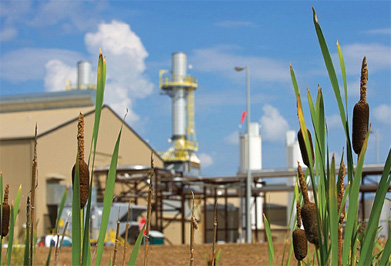
Canada has the third largest oil reserves in the world. And 97% of these reserves are in the oil sands. Oil sands are geologic formations containing a mixture of extra-heavy oil, water and sand. The petroleum resource found in the oil sands – called bitumen – is too thick for conventional extraction methods. Enhanced oil recovery methods must be used in order to make extraction viable.
Some of the largest oil sands deposits in the world are found in the Athabasca region of Northern Alberta, Canada. ConocoPhillips ranks as one of the leading steam-assisted gravity drainage (SAGD) producers and acreage holders in the Canadian oil sands. Our approximately 900 thousand-net-acres lease holdings are estimated to contain approximately 15 billion net barrels of resource.
- Technology Makes It Possible
-
In its natural state, bitumen is very similar in consistency to hard rubber. Steam-assisted gravity drainage (SAGD) is an advanced extraction method in which 2 horizontal wells are drilled into an oil reservoir and high-pressure steam is continuously injected into the upper well. The SAGD method heats the oil and reduces its viscosity, allowing it to drain into the producing well.
- Meeting the Demand
-
Importing oil sands resources currently supports thousands of U.S. jobs in the pipeline, refining and marketing industries.As oil sands production and investment in Canada increases, so will the demand for U.S. goods and services. This demand is expected to add $5.8 billion to the U.S. gross domestic product in 2015, $12.9 billion in 2020 and $26.6 billion in 2025. In total, the development of Canadian oil sands will create millions of new North American jobs and provide billions in economic activity, while improving North American energy security.
We are committed to environmental stewardship in the development of our projects, including oil sands. Technologies used for oil sands development are continuously improving and reducing their production’s environmental footprint.
- Water Management
-
Water is an integral part of the SAGD process. Most of the water used in our SAGD oil sands operations is reused, treated water. To obtain the small fraction of additional water needed for the process, we draw from a series of deep underground sources, targeting water that is unfit for human consumption and unsuitable for agricultural or livestock purposes.
We are researching new recovery processes that may reduce SAGD overall water demand. We have approved an enhanced steam-assisted gravity drainage (e-SAGD) pilot project to learn whether water demand and energy consumption can be further reduced by injecting a combination of light hydrocarbons and steam into a bitumen formation. If successful, e-SAGD effectively reduces both water usage and emissions. We are also researching improvements to water processing facilities and steam generation systems.
- Managing Greenhouse Gas Emissions
-
We recognize that there are questions about greenhouse gas (GHG) emissions from oil sands production. Industry has successfully reduced the GHG intensity per barrel of oil sands crude produced by 39% since 1990. We continue to investigate technologies focused on running our facilities more efficiently with less energy and fewer GHG emissions.
We are also designing plans for improved heat integration and testing enhanced oil production technologies, both aimed at maximizing fuel efficiency while reducing air emissions associated with steam generation. If successful, such technologies have the potential to reduce our GHG emissions from oil sands production by as much as 15 to 35%.
- Land Management
-
We minimize land disturbance in our operations through careful planning and application of our Global Onshore Well Management Principles. All of our oil sands production use in-situ recovery techniques, specifically SAGD, which recovers the oil without removing the soil and materials above it. This enables our operations to have a smaller environmental footprint with no surface mining operations. To further reduce the land footprint of SAGD, our technology group is working to increase horizontal well lengths and find alternative pad configurations, accessing more resource from less surface land.
When necessary, reclamation of disturbed sites is implemented through our Faster Forests program, which accelerates the reforestation of boreal forest through the planting of a suitable mix of native trees and shrubs.
Throughout our operations worldwide, we are committed to conducting business in a way that promotes economic growth and vibrant communities, now and in the future.